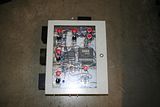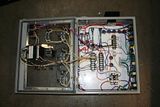I'd like to put a couple led indicator lights in the control box I'm building. I'd like to source it locally (and cheap) from radio shack.
I need a led on the DC line from my PID to my SSR to tell me when the PID is applying power to the elements. Then I think I'd also like a led on one or both of the hot legs going to the 240v 5500 watt elements so I know when the element is actually being powered (to keep me from leaving the PID on with the cutoff switch off). And maybe one more on the 120 line going to the single pump.
I'm working from the diagram P-J drew up in this thread (the first diagram with the contactors). https://www.homebrewtalk.com/f170/simple-eherms-following-pjs-diagram-w-only-1-pid-221403/
I think I only need a led on the hot leg of the element that is powered by the contactor. The other hot leg will be on if the SSR tells it to be and I can see that with the led on the dc line feeding the SSR (of course this assumes that the SSR is working correctly).
So really I need a wiring diagram for the PID output to SSR and one for the 120v lines for the pump and one leg of each element.
From what I've gathered I just need a resistor for the DC current to bring the input voltage to the correct level for the led. So the resistor and then the led are wired in parallel to the line going to the SSR. I think. The PID output is a 12v DC 30mA according to Auber's manual for the 2352 PID.
For the 120AC lines I'm more confused. Evidently the reverse polarity that occurs when the AC line alternates will destroy the led so a capacitor or bridge is needed in addition to the right resistor. But I have no idea what a capacitor or bridge looks like or how to wire it up correctly so I don't set my control box on fire.
I may forego the fancy lighting if this ends up being more work than it is worth.
I need a led on the DC line from my PID to my SSR to tell me when the PID is applying power to the elements. Then I think I'd also like a led on one or both of the hot legs going to the 240v 5500 watt elements so I know when the element is actually being powered (to keep me from leaving the PID on with the cutoff switch off). And maybe one more on the 120 line going to the single pump.
I'm working from the diagram P-J drew up in this thread (the first diagram with the contactors). https://www.homebrewtalk.com/f170/simple-eherms-following-pjs-diagram-w-only-1-pid-221403/
I think I only need a led on the hot leg of the element that is powered by the contactor. The other hot leg will be on if the SSR tells it to be and I can see that with the led on the dc line feeding the SSR (of course this assumes that the SSR is working correctly).
So really I need a wiring diagram for the PID output to SSR and one for the 120v lines for the pump and one leg of each element.
From what I've gathered I just need a resistor for the DC current to bring the input voltage to the correct level for the led. So the resistor and then the led are wired in parallel to the line going to the SSR. I think. The PID output is a 12v DC 30mA according to Auber's manual for the 2352 PID.
For the 120AC lines I'm more confused. Evidently the reverse polarity that occurs when the AC line alternates will destroy the led so a capacitor or bridge is needed in addition to the right resistor. But I have no idea what a capacitor or bridge looks like or how to wire it up correctly so I don't set my control box on fire.
I may forego the fancy lighting if this ends up being more work than it is worth.



